
The Endangered Species Act of 1973 is the primary law in the United States for protecting imperiled species. Designed to protect critically imperiled species from extinction as a "consequence of economic growth and development untempered by adequate concern and conservation", the ESA was signed into law by President Richard Nixon on December 28, 1973. The U.S. Supreme Court called it “the most comprehensive legislation for the preservation of endangered species enacted by any nation". The purposes of the ESA are two-fold: to prevent extinction and to recover species to the point where the law's protections are not needed. It therefore “protect[s] species and the ecosystems upon which they depend" through different mechanisms. For example, section 4 requires the agencies overseeing the Act to designate imperiled species as threatened or endangered. Section 9 prohibits unlawful ‘take,’ of such species, which means to “harass, harm, hunt...” Section 7 directs federal agencies to use their authorities to help conserve listed species. The Act also serves as the enacting legislation to carry out the provisions outlined in The Convention on International Trade in Endangered Species of Wild Fauna and Flora (CITES). The Supreme Court found that "the plain intent of Congress in enacting" the ESA "was to halt and reverse the trend toward species extinction, whatever the cost." The Act is administered by two federal agencies, the United States Fish and Wildlife Service (FWS) and the National Marine Fisheries Service (NMFS). FWS and NMFS have been delegated the authority to promulgate rules in the Code of Federal Regulations to implement the provisions of the Act.

The conservation status of a group of organisms indicates whether the group still exists and how likely the group is to become extinct in the near future. Many factors are taken into account when assessing conservation status: not simply the number of individuals remaining, but the overall increase or decrease in the population over time, breeding success rates, and known threats. Various systems of conservation status exist and are in use at international, multi-country, national and local levels as well as for consumer use.

Melocactus, also known as the Turk's cap cactus, is a genus of cactus with about 30–40 species. They are native to the Caribbean, western Mexico through Central America to northern South America, with some species along the Andes down to southern Peru, and a concentration of species in northeastern Brazil.

Bookham Commons are two commons, situated just to the north of the villages of Great Bookham and Little Bookham, in Surrey, England, 154.7 hectares in extent; the individual parts are named Great Bookham Common and Little Bookham Common. A group of dwellings known as the Isle of Wight is situated within the site, and a track, Common Road, leads to it from the northwest. Little Bookham Common lies south and west of this track, whereas Great Bookham Common lies to the east.

A near-threatened species is a species which has been categorized as "Near Threatened" (NT) by the International Union for Conservation of Nature as that may be considered threatened with extinction in the near future, although it does not currently qualify for the threatened status.
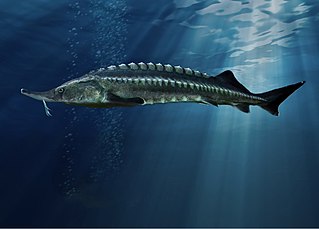
An IUCN Red List Critically Endangered (CR) species is one that has been categorized by the International Union for Conservation of Nature as facing an extremely high risk of extinction in the wild. As of 2021, there are 6,811 species that are considered to be Critically Endangered. This is out of the 120,372 species currently tracked by the IUCN.
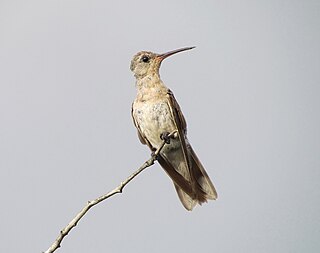
The buffy hummingbird is a species of bird in the hummingbird family Trochilidae. It is the only species placed in the genus Leucippus. This bird lives in dry forest and scrubland in northern South America where it feeds on insects and the nectar, flesh, and juice of cactus fruits.

Villa's gray shrew is a shrew native to northeastern Mexico, where it is called musaraña.

Buettikofer's shrew is a species of mammal in the family Soricidae. It is found in southern Nigeria and scantly present in Ivory Coast, Ghana, Guinea, Liberia and Sierra Leone. Its natural habitat is subtropical or tropical moist lowland forests. It is threatened by habitat loss.

Melocactus azureus is a species of cactus. It is endemic to Brazil, where it is known only from Bahia. It is locally abundant but the populations are fragmented and vulnerable to habitat degradation.

Melocactus deinacanthus is a species of plant in the family Cactaceae. It is endemic to Brazil. Its natural habitat is rocky areas. It is threatened by habitat loss.

Melocactus glaucescens is a species of plant in the family Cactaceae. It is endemic to Brazil. Its natural habitats are rocky areas and hot deserts. It is threatened by habitat loss.

Melocactus lanssensianus is a species of plant in the family Cactaceae. It is endemic to Brazil. Its natural habitats are rocky areas and hot deserts. It is threatened by habitat loss.
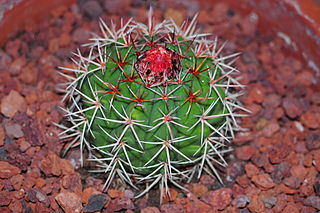
Melocactus pachyacanthus is a species of cactus. It is endemic to Brazil, where it is known only from two locations in Bahia. Its populations are fragmented and it is vulnerable to habitat degradation.
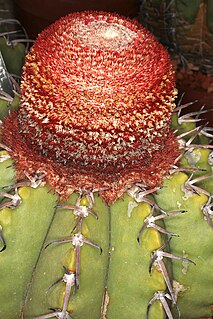
Melocactus paucispinus is a species of cactus. It is endemic to Brazil, where it is known only from Bahia. Its populations are scattered in sand and gravel substrates.

Melocactus violaceus is a species of plant in the family Cactaceae. It is endemic to Brazil. Its natural habitats are dry savanna and sandy shores. It is threatened by habitat loss.

A vulnerable species is a species which has been categorized by the International Union for Conservation of Nature as likely to become endangered unless the circumstances that are threatening its survival and reproduction improve.
Melocactus caroli-linnaei is a cactus found in Jamaica. When mature it is columnar, up to 1 m (3.3 ft) high. Like all species of Melocactus, it forms a "cephalium" when mature – a dense mass of areoles covered with wool and spines at the tip of the stem. Flowers are produced only from the cephalium.
Laccornis conoideus is a species of predaceous diving beetle in the family Dytiscidae. It is found in North America.
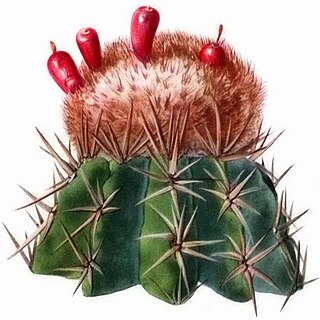
Melocactus lemairei is a species of cactus endemic to the Caribbean island of Hispaniola. It is named after French botanist and cactus expert Charles Antoine Lemaire.



















